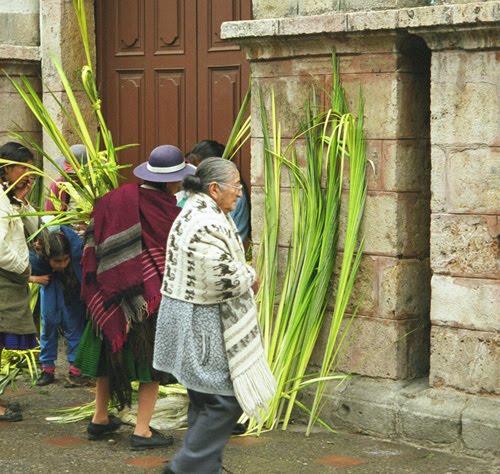Prayer: Hosanna
 Hosanna in the highest!
Today begins our week-long parade that starts overlooking Jerusalem and ends with an empty tomb. We will take time to gather around the table on Thursday and mark the Last Supper. On Friday, we remember that before resurrection comes betrayal, crucifixion, suffering, and death. And at first light on Sunday, we will find the stone rolled away, and sprint to share the news.
Hosanna in the highest!
Today begins our week-long parade that starts overlooking Jerusalem and ends with an empty tomb. We will take time to gather around the table on Thursday and mark the Last Supper. On Friday, we remember that before resurrection comes betrayal, crucifixion, suffering, and death. And at first light on Sunday, we will find the stone rolled away, and sprint to share the news.
But first things first: Hosanna!
It’s the word the crowds cry as they gather along the roadside. Hosanna! As Jesus rides down from the Mount of Olives, they place their cloaks in his path. Hosanna! They cut branches, waving them and laying them in the road, too. Hosanna! The crowds surrounded Jesus, shouting and praying, “Hosanna!”
What is the “Hosanna”? It must be some Hebrew word of praise. They call Jesus the “Son of David,” invoking the name of the great ancient king. “Blessed is the one who comes in the name of the Lord,” they cry. They have some inkling of who he is and what this entry to Jerusalem must mean. “Hosanna in the highest heaven!” They are taking this one all the way to the top!
Hosanna!
It’s possible that by the time of Jesus, the word meant no more to most people than a placeholder of elation, like a first century “Yay” or “Wow” or some other monosyllabic palindrome. But no doubt, there were those who knew its origins. The religious authorities, for one, knew what it meant. The disciples, too – indeed, anyone who was steeped in the faith would know what it meant. And they also knew that by virtue of the cry of “Hosanna”, this was far more than a simple peasants’ parade. This was a procession meant to challenge the very heart of politics and religion as they were known, an affront to the Jerusalem status quo.
“Hosanna” does come from an old Hebrew phrase, but one that was less praise and more desperate plea. “Save now!” It was a phrase stripped of all pretense of politeness. “Help!” Its insistent cry was one reserved for royalty or divinity. “Deliver us! Don’t wait!” The people are either calling Jesus “king” or “God” or both.
In other words, this “Hosanna” lets us know that the crowds are not simply uttering prayers of praise. They are anointing the leader of a coup!
In the first century, the people of Judea were laboring under a triple occupation. The Romans had claimed this important geography as their own, controlling this crucial trading zone where three continents come together. Conspiring with this foreign Empire was King Herod, a figurehead Jewish ruler who was far more concerned with his own tentative grip on regional power than he was with the well-being of his people.
And the religious establishment colluded, too. The priests and scholars, the keepers of the traditions of priests and prophets that came before, were more interested in ritual purity than they were in sacred concepts like righteousness and justice, especially if invoking them might mean losing what little authority they had.
Hosanna indeed! This was a people in need of being saved, and they pinned their hopes on this Jesus, this prophet from Nazareth in Galilee, crying out to him on the road and following him into the city.
What happens next is where the story turns. Instead of heading to Herod’s palace and using the surging crowd to overthrow the puppet, Jesus heads to the Temple. He flips over tables and drives out the merchants. It’s a scathing action that put him at the top of the hit list, revealing that those in charge were more concerned with power than faithfulness.
By ending at the Temple, Jesus took a risk. And it probably lost him the crowds. It is only a few days later that those who cried out to him as Savior are now calling for his crucifixion. Hosanna indeed.
Are we like the crowds? Sadly, probably so. We can be fickle. We are eager to cheer Jesus on when he agrees with us. We are ready to turn our back on him when he discomforts us. So what would it look like for us to be those crowds, embracing Hosannas, crying out to Jesus as he enters into the heart of it all, but instead of turning tail, following him to the bitter end?
My own mind is drawn today to Anne Lamott’s book, which you have heard us reference a few times: Help, Thanks, Wow: The Three Essential Prayers. In it, Lamott says that all prayers boil down to these three simple words: help, thanks, wow. And more often than not, these concepts overlap and run together. Lamott tells the story of an outing with her friend Barbara when she was in the final stages of ALS. Lamott asked her, “What are you most grateful for these days?” Her response, from the midst of precipitous decline, was this: “The beauty of nature, the birds and flowers the beauty of friends.” Even there in the midst of suffering, where the daily plea for “help” was surely at the forefront, Barbara still had the presence of mind to say “thanks”.
I think a truly holy Hosanna can hold these three words together, this help, thanks, and wow. Hosanna cries for deliverance. It calls out in gratitude. And it gives voice to holy awe.
What is your prayer today? What is your commitment to grow into daily prayer?
That’s the thing about following this Jesus: it’s risky stuff. We may want him to go to Herod’s palace, but that’s the moment when he’ll head toward the Temple. We may hope he’ll agree with us and what we’re already sure we know is true, but that’s the moment that he’ll challenge us directly and reveal to us what Truth really looks like.
And isn’t that what faithfulness is all about? It’s a journey, a parade, with stops and stumbles along the way, full of moments of both doubt and certainty, of hesitation and growth. It’s a procession whose ultimate destination will remain shrouded in mystery, but a holy mystery embodied in this royal, divine Jesus.
Hosanna indeed?
Hosanna indeed!
